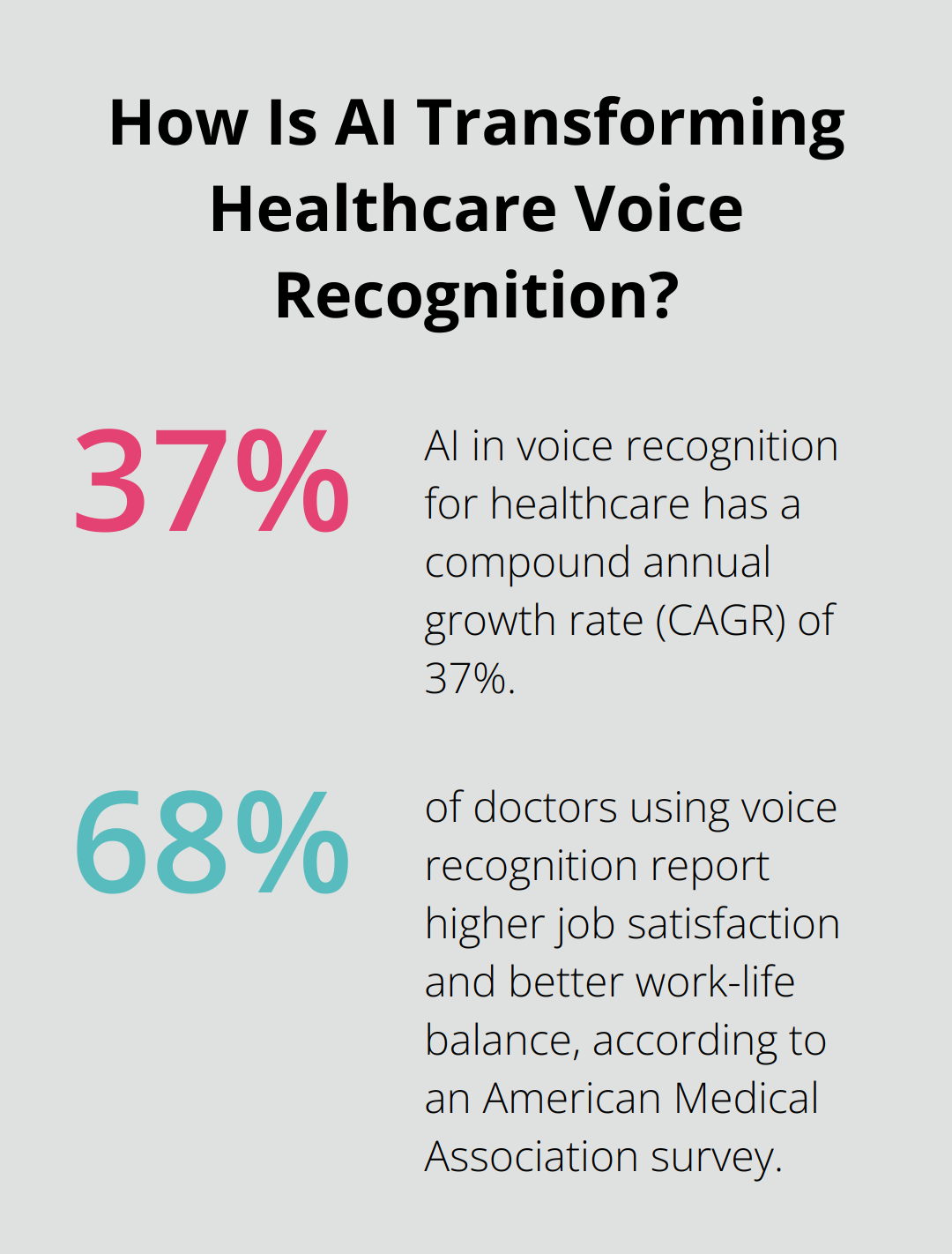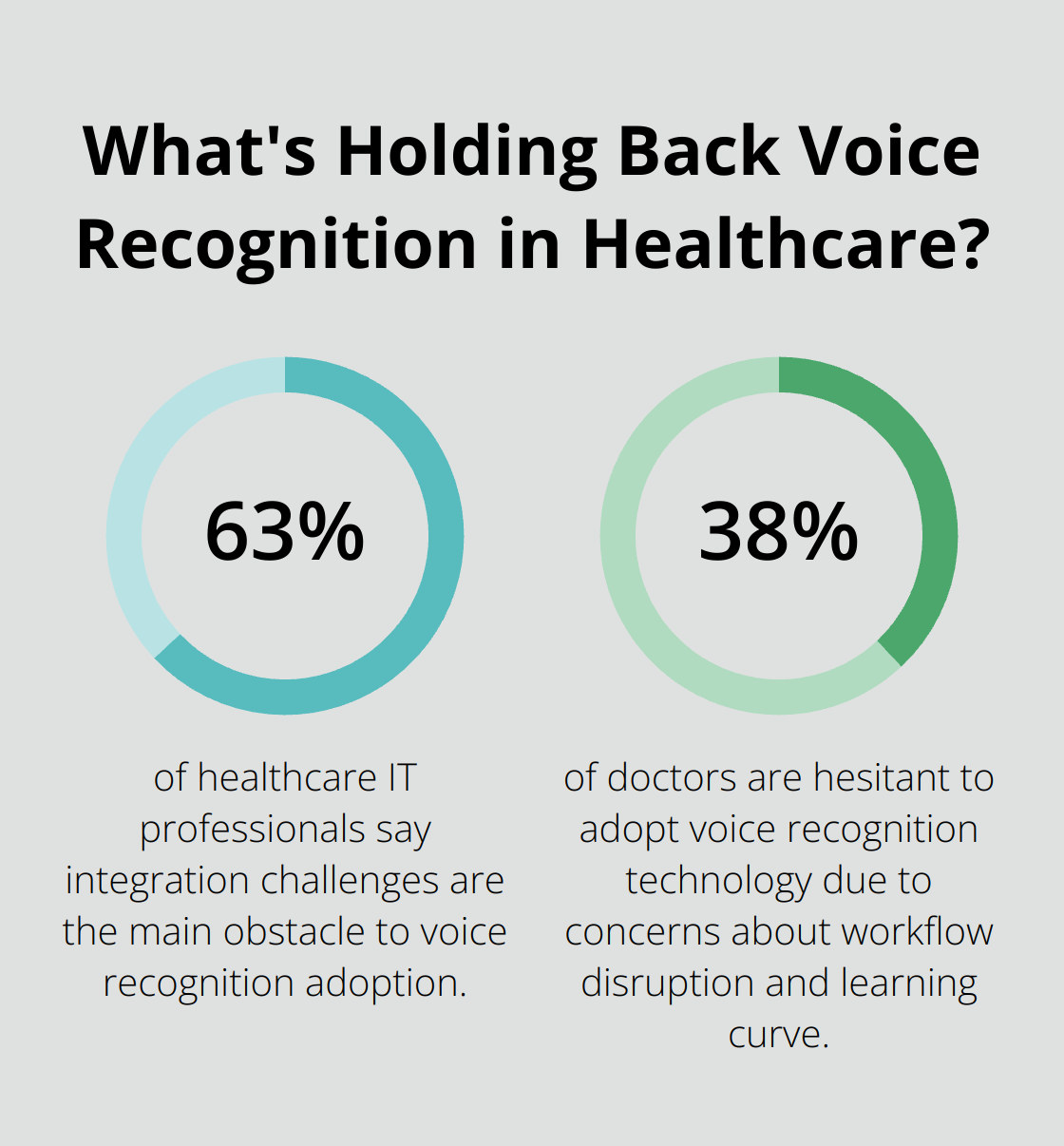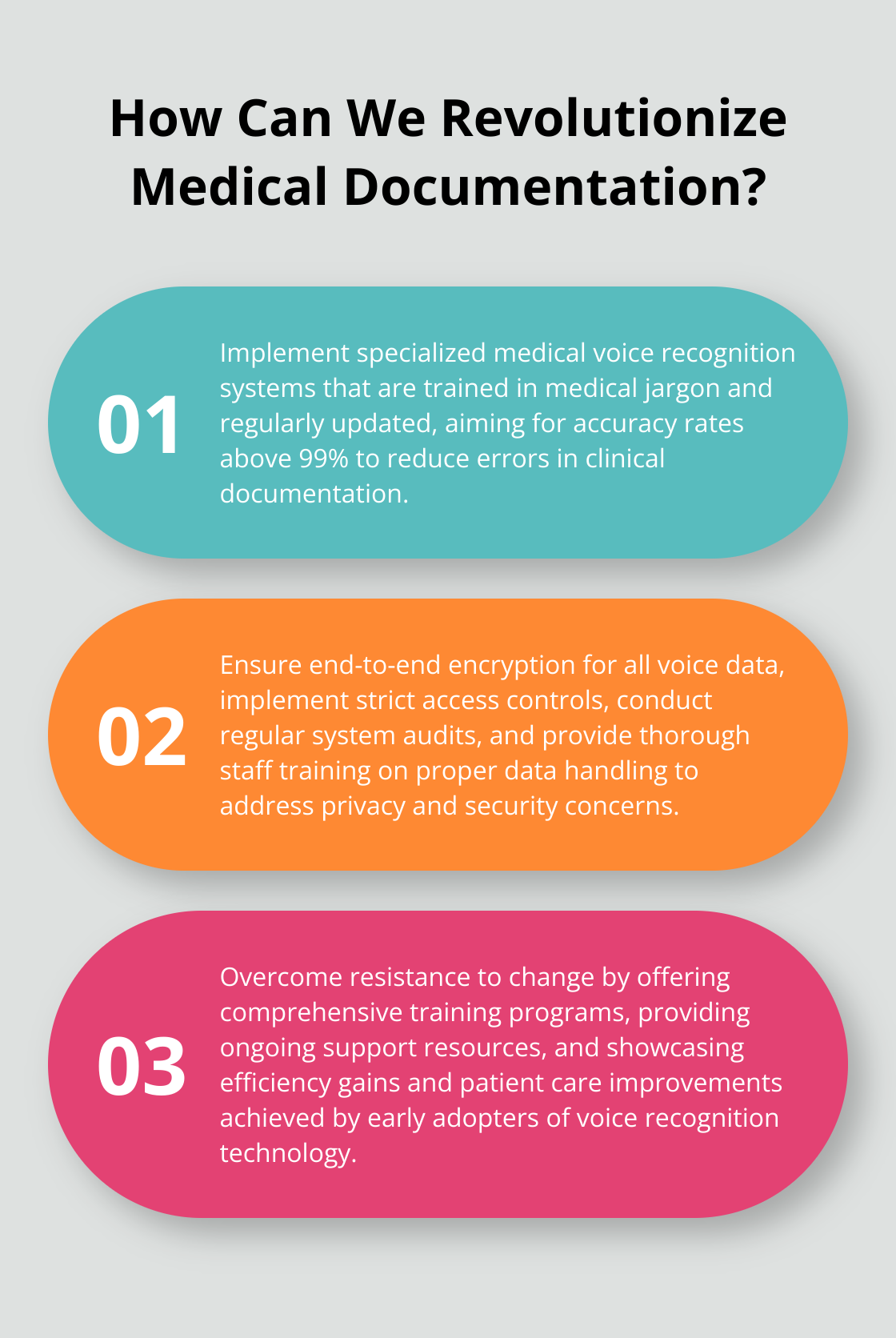Voice recognition technology — it’s shaking up healthcare in 2025 like never before. At ScriberJoy, we’ve seen it taking over medical spaces — from jam-packed emergency rooms to the chill vibe of private practices.
Consider this your go-to guide on voice recognition in healthcare: the now, the perks, the bumps in the road, and what’s around the corner. We’re talking major upgrades in clinical documentation, a real boost in patient care, and a smoother ride for all those admin tasks.
Voice Recognition in Healthcare Today
Voice recognition tech in healthcare-2025, folks, it’s like a rocket ship right now. You’ve got AI zooming up the charts as one of the standout performers in this space, sporting a compound annual growth rate (CAGR) of 37%. Feel free to let your jaw drop.
Market Leaders and Emerging Players
Dragon Medical One, a Nuance Communications brainchild (Microsoft’s little gem now), still holds the throne. But newbies like ScriberJoy? They’re hustling-special features for medical transcription that are the talk of the town.

And don’t forget about the big dogs-Amazon’s Transcribe Medical and Google’s Cloud Speech-to-Text API. They’ve carved out substantial pieces of the pie, especially with those big healthcare systems digging scalable, cloud-based solutions. Who wouldn’t, right?
Market Growth and Adoption Rates
This voice recognition market is like that snowball rolling downhill-picking up speed and size. Fast. The Speech and Voice Recognition arena is expected to hit-you ready for this?-$29.4 billion by 2026, rocking an estimated CAGR north of 14.9%.
Real-World Impact on Healthcare Providers
Dr. Sarah Chen, the big cheese at Metro General Hospital, is singing the praises-talking about a hefty 45% cut in documentation time thanks to voice recognition tech. “This isn’t just about saving time,” she says. “It’s about handing that time back to patient care.” Talk about a win-win.
And get this-a survey from the American Medical Association spills the beans: 68% of docs using voice recognition are reporting higher job satisfaction and a better work-life vibe. Who knew satisfaction was just a tech upgrade away?
Technological Advancements
As 2025 charges ahead, voice recognition in healthcare-can’t avoid it, people. It’s the linchpin for efficient, patient-first care. The tech is constantly evolving, AI is getting sharper, and the context? More understood than ever. Talk about pushing limits.
The next big leap for voice recognition? It’s in all the diverse applications-improving clinical docs, amping up patient care-it’s ready to shake things up across the board in healthcare delivery. Buckle up.
How Voice Recognition Revolutionizes Healthcare
So, it’s 2025, and voice recognition is running wild in healthcare-changing everything from efficiency to patient interaction. It’s like healthcare got a turbo boost and a new social life thanks to talking tech.
Supercharging Clinical Documentation
Voice recognition software makes the paperwork drag race a thing of the past. A recent study checks out the transcription chops of four different Automatic Speech Recognition (ASR) systems in healthcare spheres. This dive into techy goodness shows that voice recognition can supercharge how we handle clinical notes.

Over at Metro General Hospital, they slapped some voice recognition gear into place and-boom-a 30% bump in the number of patients seen each day. Dr. Chen chimes in, “We’re doing patient notes live, accuracy’s up, and the paperwork pile is down.”
Elevating Patient Care
And then there’s the fun part-actually talking to patients. Some experts argue mixing AI and medical care lets clinicians ditch the dull tasks and dive into meaningful conversations.
The nerdy part? The software knows its medical lingo and avoids those ‘Oops, did I type that wrong?’ moments compared to clunky typing. Fewer mistakes mean happier patients-take Eastside Medical Center, for example, where they’ve knocked medication errors down by 15% using voice tech.
Streamlining Administrative Tasks
It’s not just about the docs and nurses. Admin folks get a break too. Voice commands now do the heavy lifting for appointment bookings, test orders, and inventory shuffling.
Central Hospital saw the admin workload shrink by 40% via voice-enabled scheduling and inventory control. And with resources freed up for patient care-hello, 20% hike in patient satisfaction scores.
Enhancing Accessibility and Inclusivity
Talking tech is changing the accessibility game, folks. Patients dealing with mobility or vision hurdles can chat with medical records, schedule stuff, and get med reminders-all by speaking up.
At Westside Community Clinic, a voice-activated reminder program bumped appointment adherence by 35% among elderly folks. It’s like a friendly nudge, more of that, please!
Supporting Medical Research and Data Analysis
Voice recognition struts its stuff in the research realm, too. With fast and precise data entry on lock, researchers can chat their findings, jot down experiment results, and annotate images all by voice.
The National Institute of Health reports a 25% research productivity uptick (study completion’s the name of the game) since embracing voice tech in their labs. There’s no slowing down now.
The voices aren’t just here to stay; they’re set to solve more healthcare puzzles. The holy grail? Plugging this tech into artificial intelligence for real-time clinical brainpower during check-ups. Oh, and medical transcription platforms are vital teammates in keeping healthcare documentation as sharp as it’s ever been.
Navigating Voice Recognition Hurdles in Healthcare
Voice recognition in healthcare – a potential game-changer, no doubt – isn’t all sunshine and rainbows. Plenty of hoops to jump through. Providers need to eyeball these issues if they want to hit a home run with this tech. So, let’s dive in – hurdles and how to leap over them.
Accuracy Concerns in Medical Contexts
Get this – accuracy is king in healthcare, period. And yeah, voice recognition systems? They’re not infallible. An error rate tipping over 7% in clinical docs produced by these systems screams for human checks and balances. Mistakes here? We’re talking major oopsies – wrong diagnosis, miscalculated meds.

Solution? Go for those specialized medical voice recognition systems. These are the ones nailing accuracy rates north of 99% ’cause they’re trained in the jargon. Think regular updates and clever algorithms that just keep getting sharper with time.
Tackling Privacy and Security Issues
Welcome to healthcare, where HIPAA rules the roost. Your voice recognition systems better guard that sensitive patient data like it’s the crown jewels. Check out this HIMSS survey – there’s a gnarly gap in how AI is governed in healthcare. A hefty chunk of organizations are just winging it, letting AI fly without a pilot.
Here’s the playbook:
- Dial in end-to-end encryption on all voice data
- Clamp down with strict access controls
- Audit those systems like nobody’s business
- Drill proper data handling into staff DNA
Seamless Integration with Existing Systems
Hooking voice rec tech into existing Electronic Health Records (EHR) systems – easier said than done. Gartner spills the beans – 63% of healthcare IT folks say integration hiccups are the bogeyman of voice rec adoption.
Crack this problem by:
- Picking voice tech with beefy API mojo
- Partnering up tight with IT teams and vendors
- Stress-test before the full-scale rollout – better safe than sorry
- Roll it out in phases, test the waters, and tweak early
Overcoming Resistance to Change
Doctors – pros at saving lives but not always thrilled about new gadgets. American Medical Association’s 2024 survey spills that 38% of docs are skittish about hopping on the voice rec bandwagon due to fear of workflow chaos and a steep learning curve.
Steer this ship by:
- Offering comprehensive training camps
- Back it up with resources and support
- Go with early adopters – show them the goods
- Throw some numbers at it – efficiency jumps, patient care upsides
Nail these challenges straight on, and providers can make voice recognition tech work wonders. The golden ticket? A system that’s a whiz at accuracy, a fortress of security, a master of integration, and a buddy with backup support.
Final Thoughts
Voice recognition in healthcare? It’s set to explode. We’re looking at an exponential rise, folks. With natural language processing and machine learning in hyperdrive, this tech is gonna soar. These leaps forward mean healthcare pros can zero in on patient interaction-not get bogged down by paperwork.

But hey, don’t just dive in headfirst. Healthcare organizations need to be smart about this-strategic, even. They have to evaluate what they really need, pick solutions that fit like a glove with current systems, and keep accuracy and security front and center. And let’s not forget-training, training, training. That’s the secret sauce for smooth sailing and reaping the full rewards of this game-changing tech.
At ScriberJoy, we’re riding this wave. Our medical transcription software fuses AI brawn with human savvy to nail accurate medical documentation. We’re throwing down the gauntlet for healthcare organizations to check out how voice recognition can ratchet up their efficiency, precision, and patient-centric focus.

Leave a Reply
You must be logged in to post a comment.